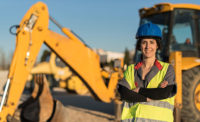How to improve your visibility on a construction site

In your life outside work, you might be as visible or as low-key as you want. But on a construction site, where struck-by accidents are a constant concern, there’s only one way to operate safely: as visibly as possible. Visibility is so important because, on a construction site, the visual landscape tends to be crowded and full of information. People going back and forth, machinery being operated, piles of materials and safety signs — between all of these, it can be tough for a heavy equipment operator to see that a worker is there before it’s too late.
And that doesn’t even account for the many workers in highway construction zones who constantly work around vehicle traffic. How can construction workers make sure they’re always working at the maximum level of visibility? We’ll talk about hi-vis clothing, safety around vehicles and more key elements of construction site visibility.
1. Wear the required level of high visibility gear.
First and foremost, you should make sure that you’re as easy to visually identify as possible. The easiest way to do this is by wearing the right high visibility gear. Start by reading up on the ANSI 107 standard and find out if you’re required to wear hi vis gear with a certain ANSI rating.
There are tons of different types of hi vis gear, including construction vests, jackets, pants, and more. Most contracting companies will specify a required level of hi vis workwear for each job site, and some may even pay for their workers’ gear. Whatever type it is, and whoever is paying for it, make sure that your visibility apparel is squared away before you set foot on the job site.
2. Add extra high visibility accessories to your workwear outfit.
The more high visibility pieces on your outfit, the more you’ll stand out in the visual field. Adding extras like hats and gloves can make a real difference in how easy it is for an equipment operator to see you in time to avoid an accident.
Some of these accessories, like hard hats, might be required by your job site safety rules. Others, like a hi-vis beanie on a cold day, might simply be common sense. Choose hi-vis gear that’s compatible with the rest of your outfit — like a hi-vis balaclava that fits over your hard hat. It could make all the difference in whether a vehicle operator can see you or not.
3. Know vehicles’ blind spots and stay clear of them.
Every large vehicle will have blind spots where the operator’s vision can’t reach. The exact location of the blind spot will vary between vehicles but, typically, a good rule is that if you can’t see the vehicle operator, they can’t see you. Stay out of these blind spots or alert the vehicle operator if you have to enter them.
Sometimes, it might be your job to give a large vehicle hand signals to help the vehicle operator back up or perform other operations. Vehicle signaling requires a definite knowledge of where the vehicle’s blind spot is, and you need to be extremely careful not to accidentally step into it as you help direct the vehicle.
4. Use easily visible motions when giving a vehicle hand signals.
As we just mentioned, a worker might sometimes need to give hand signals to a vehicle operator to help them back up the vehicle or complete another tricky task. When you’re doing this, there are a couple of crucial safety precautions you should follow.
First, know the right construction hand signals to use so that you don’t accidentally give the operator the wrong instructions. Second, make sure your movements are large and exaggerated when you’re doing it. Don’t go so over the top that you distort the motion of the signal, but prioritize being seen and understood. Finally, again, make sure your hi vis gear is rated for the position you’re working in.
5. Use the buddy system and/or lone worker devices to make sure you’re never off the radar.
Working with others means there’s always someone there to help in an emergency, but workers can have difficulty accessing help if an accident happens while they’re working in an isolated part of the site. The first technique to prevent this, of course, is to work with a buddy instead of working alone.
In circumstances where you don’t have a buddy, try to make sure you have a lone worker device or app to keep others informed on your safety status. These tools use a variety of methods to alert other workers if someone has an accident, such as scheduled check-ins or panic buttons. On job sites where you’ll regularly be working alone, your management should be happy to provide lone worker devices for your safety.
6. Use extra caution when working in low-light conditions.
Working in low light presents many additional dangers for construction workers. Sight distance will be considerably shorter, and the glare of headlights can momentarily obscure things until it’s too late. Remember that low light doesn’t just mean night work; inclement weather such as rain or snow can also significantly reduce visibility distance.
Any job site that involves work in low light conditions should have a well-defined safety plan for addressing potential issues. Hi-vis clothing should be a given, but other solutions such as floodlights and lighted signs may also have a role to play. Managers should be using all of the means at their disposal to make low-light work safer.
Safety always needs to be the number one priority on the job, and visibility is one of the cornerstones of job site safety. Follow these tips and model them for others — you might be surprised at the value of a good role model for the safety culture on a job site.
Looking for a reprint of this article?
From high-res PDFs to custom plaques, order your copy today!








